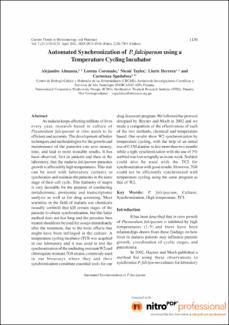Separation of Plasmodium falciparum Late Stage-infected Erythrocytes by Magnetic Means
Date
2023-03-02Author
Coronado, Lorena Michelle
Tayler, Nicole Michelle
Correa, Ricardo
Giovani, Rita Marissa
Spadafora, Carmenza
Metadata
Show full item recordAbstract
Unlike other Plasmodium species, P. falciparum can be cultured in the lab, which facilitates its study 1. While the parasitemia achieved can reach the ≈40% limit, the investigator usually keeps the percentage at around 10%. In many cases it is necessary to isolate the parasite-containing red blood cells (RBCs) from the uninfected ones, to enrich the culture and proceed with a given experiment. When P. falciparum infects the erythrocyte, the parasite degrades and feeds from haemoglobin 2, 3. However, the parasite must deal with a very toxic iron-containing haem moiety 4, 5. The parasite eludes its toxicity by transforming the haem into an inert crystal polymer called haemozoin 6, 7. This iron-containing molecule is stored in its food vacuole and the metal in it has an oxidative state which differs from the one in haem 8. The ferric state of iron in the haemozoin confers on it a paramagnetic property absent in uninfected erythrocytes. As the invading parasite reaches maturity, the content of haemozoin also increases 9, which bestows even more paramagnetism on the latest stages of P. falciparum inside the erythrocyte. Based on this paramagnetic property, the latest stages of P. falciparum infected-red blood cells can be separated by passing the culture through a column containing magnetic beads. These beads become magnetic when the columns containing them are placed on a magnet holder. Infected RBCs, due to their paramagnetism, will then be trapped inside the column, while the flow-through will contain, for the most part, uninfected erythrocytes and those containing early stages of the parasite. Here, we describe the methodology to enrich the population of late stage parasites with magnetic columns, which maintains good parasite viability 10. After performing this procedure, the unattached culture can be returned to an incubator to allow the remaining parasites to continue growing.

